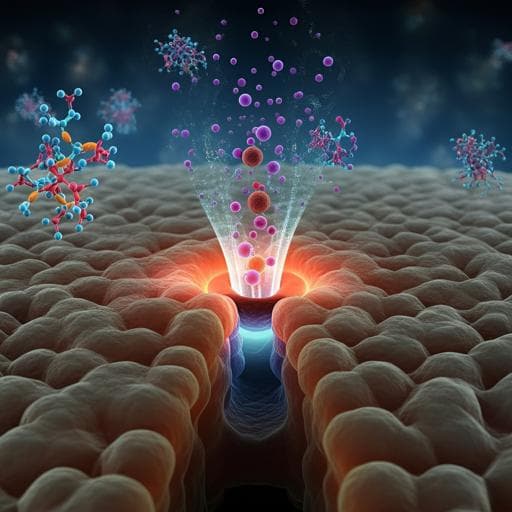
Chemistry
Single-sulfur atom discrimination of polysulfides with a protein nanopore for improved batteries
F. Bétermier, B. Cressiot, et al.
This innovative research conducted by Fanny Bétermier and colleagues reveals a groundbreaking method for detecting polysulfides in sulfur-based batteries using biological membranes and nanopore sensors. Their study showcases remarkable single-molecule discrimination capabilities, paving the way for enhanced battery performance and longevity.
~3 min • Beginner • English
Introduction
The study addresses the challenge of improving battery lifetime and reliability by introducing intelligent, selective separator functionalities. While Li-ion batteries dominate current technology, managing parasitic species such as soluble polysulfides in sulfur-based systems remains a key problem. Inspired by biological self-repair strategies and supramolecular chemistry, cyclodextrins are highlighted for their temperature-dependent host–guest molecular recognition, enabling reversible capture/release of target species. The authors explore whether protein nanopores, particularly α-hemolysin equipped with a β-cyclodextrin adapter, can be leveraged as highly sensitive, single-molecule sensors for discriminating sodium polysulfides differing by a single sulfur atom in aqueous media. The purpose is twofold: to quantify cyclodextrin–polysulfide complexation (stoichiometry and affinity) and to demonstrate nanopore-based single-sulfur atom discrimination, opening avenues for smart, responsive separator membranes and in situ electrolyte sensing in battery systems.
Literature Review
Prior work has developed self-healing battery materials using supramolecular interactions and bio-inspired polymers, with cyclodextrins employed in thermal switches, drug delivery, molecular adapters for nanopore sensing, and battery components such as stretchable binders and ion-conducting membranes. Cyclodextrin polymers have been used to trap polysulfides in Li–S electrodes to mitigate the shuttle effect. Additional separator strategies involve micro-porous designs and surface chemistries to repel polysulfides. Existing analytical methods (UV–vis, X-ray, mass spectrometry, cyclic voltammetry) lack single-molecule resolution for polysulfide speciation. Nanopore technologies have achieved high-resolution analysis in biomolecular contexts (nucleic acids, peptides, amino acids, biomarkers) and can detect subtle chemical modifications. This background supports adapting nanopore sensing to battery-relevant species for enhanced diagnostics and control.
Methodology
- Polysulfide preparation: Aqueous sodium polysulfide solutions (100 mM) were prepared by reacting Na2S with elemental sulfur in stoichiometric ratios under argon in 25 mM NaHCO3 buffer at pH 10 with stirring for one week. Species (Na2S2, Na2S3, Na2S4, Na2S5) were characterized by UV–vis spectroscopy (200–1100 nm). All handling occurred in an Ar-filled glovebox.
- NMR complexation studies: 1H NMR (600 MHz) in D2O (25 mM NaHCO3, pH 10, 298 K) monitored cyclodextrin proton chemical shifts upon titration with polysulfides. Job’s plots (continuous variation) established 1:1 stoichiometry for cyclodextrin (α, β, γ)/Na2S5 complexes. Binding isotherms (fitting a 1:1 model) provided association constants Ka and Δδmax from selected protons (notably H3). Error estimates considered standard deviation (~9%) and uncertainty propagation.
- Molecular docking and MD: Docking (AutoDock Vina) assessed inclusion complexes of S3, S4, S5 with cyclodextrins using receptors from PDB structures and from MD-generated cyclodextrin conformations. MD simulations characterized cyclodextrin flexibility in 1 M NaCl and the α-hemolysin (α-HL) nanopore, estimated ionic/electro-osmotic flows, and provided effective pore area profiles for hindrance estimation. NAMD with CHARMM36/CGenFF and TIP3P was used; CUFIX corrections applied to ions. Two plausible α-HL protonation states at pH 10 were evaluated.
- Nanopore electrical detection: Planar lipid bilayers (diphytanoyl-PC in decane) were formed across a 150 µm aperture separating cis/trans chambers (1 M NaCl, 25 mM NaHCO3, pH 10, under argon). A single α-HL pore was inserted; β-cyclodextrin (β-CD) or Na2Sx/β-CD complexes were added to the trans side. Currents were recorded (4.17 MHz sampling, 10 kHz filter). Event analysis distinguished brief bumping events from longer interaction events; blockade ratio (Io − Ib)/Io and dwell times were quantified to discriminate β-CD vs complexes.
- Nanopore hindrance estimator: A quasi-1D resistance model estimated qualitative blockade trends using effective area profiles from MD for open pore and β-CD-occluded pore; polysulfide occupancy was approximated by subtracting a constant area segment corresponding to S3/S4/S5 volumes.
- Temperature-responsiveness: 1H NMR temperature cycling experiments quantified complexed fraction (ΔH3/ΔH3max) for α-CD/Na2S5 between 25–60 °C to assess reversible association/dissociation kinetics.
Key Findings
- Stoichiometry: Job’s plots confirm 1:1 inclusion complexes for α-, β-, and γ-cyclodextrins with Na2S5 in aqueous buffer.
- Affinities for Na2S5 by cyclodextrin type (NMR, 298 K): β-CD shows the strongest binding: Ka(S5) = 181 ± 4 M−1; α-CD: 62 ± 11 M−1; γ-CD: 52 ± 9 M−1. Docking affinity rankings agree, favoring β-CD.
- Chain-length dependence with β-CD (NMR): Ka increases with polysulfide length: Ka(S5) = 181 ± 4 M−1; Ka(S4) = 136 ± 4 M−1; Ka(S3) = 152 ± 14 M−1 (less reliable due to small shifts), corroborated by H6 analysis and docking scores.
- Nanopore discrimination (α-HL at pH 10): Distinct blockade ratios enable single-sulfur atom resolution for Na2Sx/β-CD complexes vs free β-CD. Average blockade ratios (interaction events): free β-CD = 61.8 ± 0.3%; Na2S3/β-CD = 66.7 ± 0.2%; Na2S4/β-CD = 68.8 ± 0.1%; Na2S5/β-CD = 74.0 ± 0.3%. Event populations deconvolve into β-CD and complex contributions; the fraction of complex events (81 ± 2.5%) matches NMR complexation fraction (79 ± 4%) under the same conditions.
- Electro-osmotic flux (EOF) characterization at pH 10 via MD supports conditions favoring entry/lodging of β-CD and complexes into α-HL, enabling discrimination.
- Hindrance estimator qualitatively reproduces the trend of larger current blockades with increasing polysulfide size, consistent with experiments.
- Thermo-responsiveness: α-CD/Na2S5 complex shows reversible, temperature-dependent association: complexed fraction 84.3 ± 0.1% at 25 °C vs 55.1 ± 0.1% at 60 °C, indicating fast, reversible capture/release over a narrow temperature window.
Discussion
The work demonstrates that protein nanopores can discriminate supramolecular complexes that differ by a single sulfur atom, addressing the need for high-resolution speciation of parasitic redox intermediates in sulfur-based batteries. Stronger binding of longer polysulfides within β-cyclodextrin cavities and their selective capture by α-HL result in distinct, quantifiable current blockades. The agreement between NMR complexation fractions, docking/MD insights, and nanopore event statistics validates the approach and mechanism (inclusion complex formation and nanopore lodging). This capability opens the door to nanopore-based, single-molecule sensing of electrolyte composition and the design of cyclodextrin-functionalized, responsive separator membranes that can trap and thermally release polysulfides on demand, potentially mitigating the shuttle effect while maintaining electrochemical participation.
Conclusion
By integrating NMR spectroscopy, molecular docking/MD, and α-HL nanopore sensing, the study establishes 1:1 inclusion complexation between cyclodextrins and sodium polysulfides, with β-cyclodextrin exhibiting the highest affinity and a clear dependence on polysulfide chain length. Crucially, nanopore measurements discriminate Na2S3, Na2S4, and Na2S5 complexes at single-sulfur resolution via distinct blockade ratios. The thermo-responsive behavior of the complexes suggests strategies for regenerative, stimuli-responsive separator membranes. Future research should adapt the methodology to non-aqueous electrolytes relevant to Li–S systems, develop robust solid-state nanopores compatible with organic solvents, and extend sensing to other parasitic electrolyte species (e.g., alkyl carbonates).
Limitations
- The demonstrated sensing and complexation measurements were performed in aqueous media; translating to non-aqueous battery electrolytes is non-trivial due to different dielectric environments and altered complexation equilibria.
- Biological nanopores and lipid bilayers are unsuitable for organic electrolytes; solid-state nanopores will be required for realistic battery conditions.
- The nanopore hindrance estimator provides qualitative trends only, relying on continuum approximations that neglect nanoscale and double-layer effects.
- NMR determination of Ka for Na2S3/β-CD has higher uncertainty due to small chemical shift changes.
- Temperature-dependent NMR was limited to 60 °C by instrument constraints; full dissociation behavior at higher temperatures was inferred but not directly measured.
Related Publications
Explore these studies to deepen your understanding of the subject.







